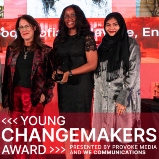Asiya Bakht 10 Jun 2024 // 4:55AM GMT

The knowledge gap is a major obstacle for big corporations seeking to implement AI, despite widespread belief in its transformative potential.
This was one of the key messages to emerge from a panel session conducted by WE Communications in collaboration with PRovoke Media and APACD to discuss the latest Brands in Motion study, titled "Bridging the AI Expectation Gap". The study involved interviewing 2,900 global technology executives across eight markets, including four countries in APAC: Singapore, Australia, China, and India.
Moderated by PRovoke Media's Arun Sudhaman, the panel featured Daniel Fieler, senior director of communications APJ at Service Now; Google global communications VP Meenu Handa; Daryl Ho, MD of WE Singapore; and Watatawa Asia-Pacific MD Stephen Robertson.
The findings were presented at the event by WE Communications Asia-Pacific executive MD Nitin Mantri, who noted that “everyone is talking about AI and now is the time for businesses to translate that energy into action. This is a race, and every moment of hesitation puts you further behind."
The research revealed that 83% of business leaders are optimistic about the benefits AI will bring to their organization while 92% have at least some concerns around the greater adoption of AI in their organization. 37% of business leaders actively talk about AI’s benefits within their organization, but 54% have no current investment in AI training.
“We haven't implemented a lot of it. I think it's not just the speed, but I think it's also the knowledge gap. I think if you expect leaders to understand the technology so complex, it becomes difficult. Most of the CEOs couldn't even come to grips when digitization happened,” Ho said.
Handa pointed out that while AI technology has been used for a long time, it’s important to remember that it's generative AI which is democratizing our ability to use AI.
“Whenever there's a gap in understanding then it's the myths and the doom scenarios that tend to play out. So it is very important for people to be much more aware of what AI really is… think it's important for us to keep that education going because it serves two or three purposes. There is a whole thing of augmentative and assistive technology for individuals, but there's a huge productivity capability enhancement for organizations.”
When asked how communicators should be addressing the challenge of the AI expectation gap, Robertson called closing the AI gap the greatest communication challenge of our times.
“It's fascinating to study the gap. Most of us here have grown up with Moore's Law. We are quite familiar with technology innovation. We've lived through the launch of operating systems, search engines, cloud computing, and normally we're quite used to that kind of six-to-eight-year gestation period where a new technology comes along and then it becomes kind of mainstream…This feels so much faster.”
Robertson believes that most companies currently have an unstructured approach to AI and while they understand that it is an incredible innovation they are waiting for case studies which are difficult to find due to ad hoc usage of technology where everyone is using different tools.
On the question of how business leaders can mitigate some of the concerns around the greater adoption of AI in their organization which included cybersecurity risks, over reliance on AI technology and job elimination, Handa believes that companies and individuals will need to experiment and learn.
“The fact remains, it's like a wave. Either you can learn to ride it or you can get crashed. So really there isn't a choice. Technology has a way of doing this. It comes, it arrives and then you can't reverse it.”
Meanwhile, Ho thinks that leadership teams in companies need to educate, embrace, and seamlessly integrate AI to mitigate the risks. According to him, during digitization, companies made the mistake of hiring specialists without themselves taking the time to learn.
“They just hired somebody to do the job and then 99% of them failed for the first five years. We've all lived through some of that. I think we all collectively cannot afford to go through that sort of process again because we have better accessibility. Now you cannot say you cannot understand simple things if you just want to know there's a YouTube video for everything in the world.”
So, what can communicators do to close the gap? Panellists have a mixed opinion on this question. Fieler feels that communicators can serve as the outside voice and provide a broader perspective since companies are internally focussed.
“One of the biggest communications issues that we have, I would say has always been around influence and having the bigger picture. That's in my 25 plus years of doing PR….the other thing I would say is the echo chamber that the people live in now which has made that internal focus even more intense, where people are just really living in their own worlds and dragging them out is I find day to day becoming much, much harder.”
Ho, meanwhile, flagged fear of AI as one of the biggest challenges communicators can help address with their companies, while Robertson believes AI concerns need to be tested and based on real world experience — communicators can help by decoding the large amount of data, insight and analysis available.
“I was looking at International Labour Organization, IMF data and the language is really fluid here. The IMF will say that up to 60% of jobs will be influenced by AI. The ILO think only around six percent of global roles might be eliminated. So, the language is really fluid. I think as communicators, we have an obligation to study and make sure we're presenting a good insight and information to leaders that's contemporary because it's changing rapidly and it's getting a little bit more intellectual.”
When asked about the kind of strategies comms leaders should be deploying to foster more conversations around how AI will change things, panellists were aligned that educating and demonstrating to leaders the power and effectiveness of technology can play a role.
Robertson believes that communicators can engage leaders by focusing on meaningful actions around AI utility and action, in addition to starting conversations through workshops, seminars and demos in order to build confidence.
Meanwhile, Ho advises communicators to get leadership to assign a test and learn budget. While it might not be easy to launch it companywide, it will be helpful for leaders to understand some of the nuances.
“We'll try, try it until we figure something out. And unfortunately, unless the leadership themselves try, test and learn themselves and see the benefits or see the non-benefits of it. It's a hard sell. It's a difficult one.”



































.jpg)

















